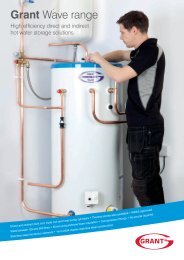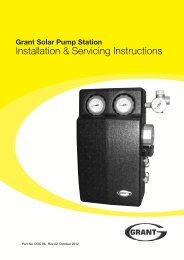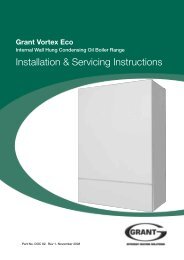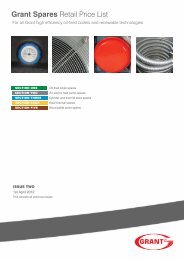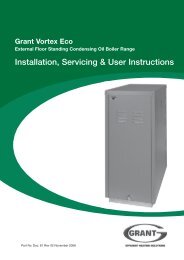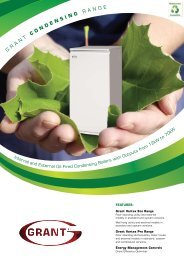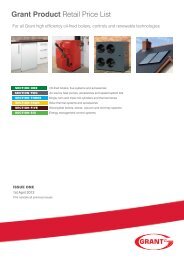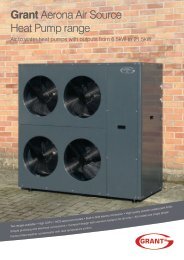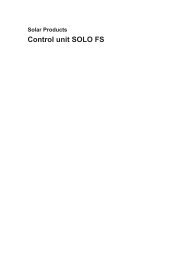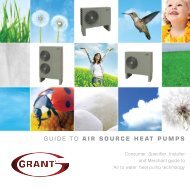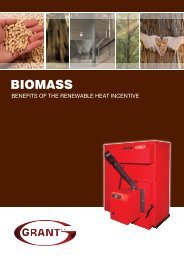Installation & Servicing Instructions - Grant UK
Installation & Servicing Instructions - Grant UK
Installation & Servicing Instructions - Grant UK
Create successful ePaper yourself
Turn your PDF publications into a flip-book with our unique Google optimized e-Paper software.
11 Boiler <strong>Servicing</strong><br />
To ensure efficient operation of the boiler<br />
it is recommended that it is checked<br />
and serviced as necessary at regular<br />
intervals. The frequency of servicing will<br />
depend upon the particular installation<br />
conditions and usage, but in general<br />
once per year should be adequate.<br />
<strong>Servicing</strong> and replacement of parts must<br />
only be carried out by a suitably qualified<br />
engineer.<br />
!<br />
Details of every service should be<br />
entered in the Service Log, in the<br />
Boiler Handbook.<br />
This information may be required to<br />
validate the <strong>Grant</strong> extended warranty.<br />
!<br />
Before starting any work on the boiler,<br />
or fuel supply please read the health and<br />
safety information given in Section 14.<br />
External equipment operated at 230 volts<br />
should not be serviced or repaired under<br />
adverse weather conditions.<br />
!<br />
CAUTION<br />
WARNING<br />
NOTE<br />
A test switch is fitted to the control<br />
panel to allow the boiler to be testfired.<br />
When On, the switch by-passes<br />
the external control system.<br />
11.1 Checking Before <strong>Servicing</strong><br />
The following sequential checks should<br />
be made before any servicing:<br />
5. Refill, vent and re-pressurise the system<br />
as necessary. See Section 7.3.<br />
6. Check that the louvres in the front<br />
panel are clear.<br />
7. Remove any sludge/water from the<br />
fuel tank by opening the sludge valve<br />
at the lower end of the tank.<br />
8. With the fuel supply valve closed,<br />
clean/replace the filter element and<br />
clean the filter bowl.<br />
9. Braided flexible fuel supply hoses (as<br />
supplied with the boiler) should be<br />
replaced annually. If long-life hoses<br />
have been installed, these should be<br />
inspected annually. If in doubt replace<br />
the hoses. In any event, these hoses<br />
must be replaced every five years.<br />
!<br />
WARNING<br />
Before servicing, set the boiler On/<br />
Off switch to Off, isolate the electricity<br />
supply and close the fuel supply valve.<br />
Allow the boiler to cool.<br />
The data label on the inside of the case<br />
side panel will indicate the fuel used and<br />
the nozzle fitted.<br />
11.2 Dismantling Prior to <strong>Servicing</strong><br />
The procedure for dismantling the boiler<br />
is as follows:<br />
1. Remove the front panel by turning<br />
the handle and withdrawing it<br />
forwards at the bottom.<br />
2. Remove the four screws securing the<br />
top panel and carefully lift it off, taking<br />
care not to damage the insulation.<br />
3. Remove the burner fixing nut (top of<br />
mounting flange) and withdraw the<br />
burner.<br />
If required, disconnect the flexible oil<br />
hose(s), use a suitable container to<br />
prevent any oil spillage.<br />
!<br />
NOTE<br />
If two flexible hoses are connected to<br />
the burner, identify (mark if necessary)<br />
which is the inlet and return if they are<br />
to be disconnected.<br />
11.3 Cleaning the Boiler<br />
The procedure for cleaning the boiler is<br />
as follows:<br />
1. Remove the nuts and washers<br />
securing the front cleaning door and<br />
withdraw the door. Take care - it is<br />
heavy.<br />
2. Remove the baffles as shown in<br />
Figures 11-1, 11-2, 11-3 or 11-4.<br />
3. Remove all deposits from the baffle<br />
plates and all the boiler internal<br />
surfaces using a stiff brush and<br />
scraper if necessary.<br />
4. Check the condition of the flue, clean<br />
as necessary.<br />
5. Check the condition of the front<br />
cleaning door seal, replace if<br />
necessary.<br />
6. Replace the baffles, ensuring they<br />
are correctly fitted. See Figures 11-1,<br />
11-2, 11-3 or 11-4.<br />
7. Pull out the spiral turbulators from<br />
the heat exchanger tubes. See<br />
Figure 11-5.<br />
1. Check the flue terminal and ensure it<br />
is not blocked or damaged.<br />
2. Run the boiler and check the operation<br />
of its controls.<br />
3. Ensure that all water/fuel system<br />
connections and fittings are sound.<br />
Remake any joints and check the<br />
tightness of any fittings that may be<br />
leaking.<br />
4. If the boiler is used on a sealed<br />
central heating system, check<br />
the system pressure, check the<br />
operation of the pressure relief valve<br />
and check the expansion vessel air<br />
charge. See Section 7.2.<br />
!<br />
NOTE<br />
The top panel has been designed to<br />
provide a slight fall away from the side<br />
positioned against a wall, the side of the<br />
top panel with the fixing screws closer<br />
to the bottom edge is the highest side<br />
and goes against the wall.<br />
2. If a sealed system kit is fitted,<br />
carefully lift up and remove the<br />
expansion vessel from the front of<br />
the boiler. Place the vessel on the<br />
floor taking care not to strain the<br />
flexible hose.<br />
8. Clean the turbulators using a stiff<br />
brush<br />
9. Test the heat exchanger condensate<br />
drain by pouring water into one of<br />
the lower tubes and observe whether<br />
the water discharges from the 22<br />
mm condensate outlet. Replace the<br />
turbulators.<br />
10. Replace the front cleaning door,<br />
ensuring the seal is in good condition<br />
and secure it in position with the nuts<br />
and washers previously removed.<br />
Tighten to form a seal.<br />
Boiler <strong>Servicing</strong><br />
33



